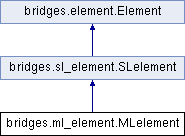 |
Bridges-Python 3.5.0
Bridges(Python API)
|
 |
Bridges-Python 3.5.0
Bridges(Python API)
|
This class can be used to instantiate Multi-list Elements. More...

Public Member Functions | |
| None | __init__ (self, **kwargs) |
| Constructor for MLelement. More... | |
| def | sub_list (self) |
| Getter for the sublist at this node if exists. More... | |
| None | sub_list (self, sl) |
| Setter for the start of a new sublist. More... | |
| str | get_data_structure_type (self) |
| Getter for the data structure type. More... | |
| def | next (self) |
| Retrieves the element following this element. More... | |
| def | next (self, n) |
| Getter for element following this element. More... | |
| bool | tag (self) |
| Getter for the tag of the element. More... | |
| None | tag (self, t) |
| Setter for the tag of the element. More... | |
| dict | get_data_structure_representation (self) |
| Getter for the data structure representation. More... | |
| def | get_list_elements (self, nodes) |
| Getter for the elements of the list. More... | |
 Public Member Functions inherited from bridges.sl_element.SLelement Public Member Functions inherited from bridges.sl_element.SLelement | |
| None | __init__ (self, **kwargs) |
| Conctructor for SLelement object. More... | |
| str | get_data_structure_type (self) |
| Getter for the data structure type. More... | |
| def | next (self) |
| Getter for element following this element. More... | |
| None | next (self, n) |
| Setter for the element following this element. More... | |
| def | value (self) |
| Getter for the SLelement value to hold. More... | |
| def | value (self, val) |
| Setter for the value that this SLelement will hold. More... | |
| def | list_helper (start) |
| helper method for graph adjacency list More... | |
| dict | get_data_structure_representation (self) |
| Getter for this data structure representation. More... | |
| def | get_list_elements (self, nodes) |
| Get the elements of the list (for internal use only) More... | |
| def | iterator (self) |
| used for range loops More... | |
 Public Member Functions inherited from bridges.element.Element Public Member Functions inherited from bridges.element.Element | |
| str | get_data_structure_type (self) |
| Get the data structure representation. More... | |
| None | __init__ (self, **kwargs) |
| Element constructor. More... | |
| object | value (self) |
| Getter for the value this element is holding. More... | |
| None | value (self, val) |
| Setter for the value of an element. More... | |
| str | identifier (self) |
| Getter for the element identifier. More... | |
| None | identifier (self, int id) |
| Setter for the element identifier. More... | |
| ElementVisualizer | visualizer (self) |
| Getter for the element visualizer. More... | |
| None | visualizer (self, ElementVisualizer vis) |
| Setter function for this element visualizer. More... | |
| LinkVisualizer | get_link_visualizer (self, el) |
| None | set_link_visualizer (self, el) |
| Setter for the link visualizer of this element. More... | |
| None | remove_link_visualizer (self, el) |
| Deleter function for the lik visualizer of this element. More... | |
| def | label (self) |
| Getter for the element's label. More... | |
| def | label (self, label) |
| Setter for the element's label. More... | |
| def | size (self) |
| Getter for the element's size. More... | |
| def | size (self, sz) |
| Setter for the element's size. More... | |
| def | color (self) |
| Getter for the element's color. More... | |
| def | color (self, col) |
| Setter for the element's size. More... | |
| def | opacity (self) |
| Getter for the element's opacity. More... | |
| def | opacity (self, op) |
| Setter for the element's opacity. More... | |
| def | shape (self) |
| Getter for the element's shape type. More... | |
| def | shape (self, shp) |
| Setter for the element's shape. More... | |
| int | id (self) |
| Get numer of ids of element object. More... | |
| def | set_location (self, locX, locY) |
| Setter for the element's location. More... | |
| def | get_locationX (self) |
| Getter for the element's location in X. More... | |
| def | get_locationY (self) |
| Getter for the element's location in Y. More... | |
| def | get_element_representation (self) |
| Getter for the element's JSON representation (for internal use) More... | |
| def | get_link_representation (self, lv, src, dest) |
| Getter for the JSON representation of the element's link (for internal use) More... | |
Additional Inherited Members | |
 Public Attributes inherited from bridges.element.Element Public Attributes inherited from bridges.element.Element | |
| color | |
| opacity | |
 Static Public Attributes inherited from bridges.element.Element Static Public Attributes inherited from bridges.element.Element | |
| int | ids = 0 |
This class can be used to instantiate Multi-list Elements.
This class extends SLelement (singly linked list element) to build multi-lists; Multilist elements contain a tag (boolean) that indicates if the element contains a sublist or not; if the tag is true, then there is a sublist beginning at this node and the starting point is the ‘sublist’ field in the element. If the tag is false, then the list continues as a normal singly linked list. The sublists are re recursive: any sublist can have its own sublists and so on. As in singly linked elements, the next pointer points to the following list element and each element contains a generic application specific object.
Multi-list elements contain a visualizer (ElementVisualizer) object for setting visual attributes (color, shape, opacity, size), necessary for displaying them in a web browser.
Elements also have a LinkVisualizer object, that is used when they are linked to another element, appropriate for setting link attributes, for instance, between the current element and its next element. In this case, the link in question is that which connects the element to the following elements; a similar logic follows for sublists.
| None bridges.ml_element.MLelement.__init__ | ( | self, | |
| ** | kwargs | ||
| ) |
Constructor for MLelement.
(str) label: the label the SLelement will hold and show on bridges visualization
(object) e: the generic object/value that this SLelement will hold
(object) next: the next element that will be assigned to this SLelement next pointer
| sublist | the MLelement that is the beginning of a sublist |
Reimplemented from bridges.sl_element.SLelement.
| dict bridges.ml_element.MLelement.get_data_structure_representation | ( | self | ) |
Getter for the data structure representation.
Reimplemented from bridges.sl_element.SLelement.
| str bridges.ml_element.MLelement.get_data_structure_type | ( | self | ) |
Getter for the data structure type.
Reimplemented from bridges.sl_element.SLelement.
| def bridges.ml_element.MLelement.get_list_elements | ( | self, | |
| nodes | |||
| ) |
Getter for the elements of the list.
| nodes | a list of the nodes |
Reimplemented from bridges.sl_element.SLelement.
| def bridges.ml_element.MLelement.next | ( | self | ) |
Retrieves the element following this element.
Reimplemented from bridges.sl_element.SLelement.
| def bridges.ml_element.MLelement.next | ( | self, | |
| n | |||
| ) |
Getter for element following this element.
Reimplemented from bridges.sl_element.SLelement.
| def bridges.ml_element.MLelement.sub_list | ( | self | ) |
Getter for the sublist at this node if exists.
| None bridges.ml_element.MLelement.sub_list | ( | self, | |
| sl | |||
| ) |
Setter for the start of a new sublist.
| sl | the MLelement that is the beginning of a sublist |
| bool bridges.ml_element.MLelement.tag | ( | self | ) |
Getter for the tag of the element.
| None bridges.ml_element.MLelement.tag | ( | self, | |
| t | |||
| ) |
Setter for the tag of the element.
| t | boolean value |